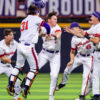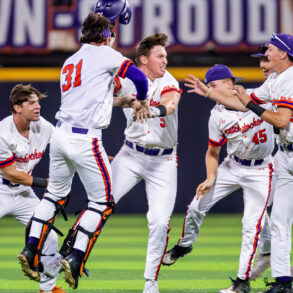Picture stepping up to the plate, the sun shining, holding a smooth wooden bat, and feeling that delightful crack as the ball soars into the outfield. That’s college baseball at its most retro. But if you listen to a college game, you’ll likely hear a much different sound — a metallic ping. So what’s the deal?

Are College Players Prohibited From Using Wooden Bats?
Not quite. Actually, wood bats are permitted in college baseball, but few people use them. The reasons why are based on decades of tradition, money talks, and a whole lot of bat science.
Let’s go back to 1974. That’s when the NCAA formally sanctioned aluminum bats for use in games. Why? Basic economics. Wooden bats crack — a lot — and repeatedly replacing them was bleeding college programs’ budgets. Aluminum bats, however, could last a season or more. That translated into fewer replacements and a whole lot less money.
Durability was not the only benefit. Metal bats also provided performance benefits, and eventually, they became the weapon of choice for almost every college team.
The Rules: Wood Is Legal, Metal Is Practical
Under NCAA Rule 1-12, bats can be made of wood or metal and used legally. But there’s a condition for metal: they must pass something referred to as the BBCOR standard (Bat-Ball Coefficient of Restitution).
This rule was added in 2011 to ensure non-wood bats don’t behave too differently from wood. That is, the NCAA wishes to maintain the offensive explosion under wraps and emphasize safety.
So yes, college players are allowed to use wood bats. But hardly anyone does — and here’s why.
Metal bats have a larger sweet spot, produce more bat speed, and make it simpler to drive the ball. Sure, the BBCOR standard evened things out a bit, but the advantages of aluminum remain.
And then there’s the matter of money. Most NCAA teams have arrangements with bat companies that provide metal bats at no cost, and wood bats are typically purchased independently and crack frequently. Florida head coach Kevin O’Sullivan put it nicely:
“If we all of a sudden are swinging a wooden bat, there’s a good chance we are not the showcase anymore.”
Wooden bats would damage the college game’s exposure and its finances. That’s why nearly all college players play metal in the spring — it’s the most effective and inexpensive choice.
See Wood in Action? Summer Leagues
Whereas metal dominates the NCAA season, summer collegiate leagues turn things around. These wood-bat leagues—such as the Cape Cod Baseball League — allow players the opportunity to swing wood like the professionals.
Why does this count? Because MLB scouts enjoy seeing players perform with wood. Hitting off a wood bat requires more skill, accuracy, and power. It distinguishes between the great and the good and sometimes gives scouts a better sense of who’s ready for the next level. Play well in one of these leagues, and your draft stock can soar.
The issue of metal vs. wood bats has created a lot of controversy. In a 2010 poll of elite NCAA coaches, most of them reported they used aluminum. Why? Price, performance, and those nice manufacturer alliances.
Still, some purists would love to see a return to wood across the board. They argue it would make the college game look and feel more like the pros — and potentially increase safety. After all, balls coming off a metal bat can reach dangerously high exit velocities. But for now, the ping remains king.
To answer the big question: Yes, college baseball players can use wooden bats — but they usually don’t. Between the economic perks of aluminum, its durability, and long-standing sponsorships, metal bats continue to dominate the NCAA landscape.
KEEP READING: How Does the College World Series Work?
Still, that iconic wooden crack isn’t extinct. You’ll find it in summer leagues, pro tryouts, and in every player dreaming of their future in the big leagues. So as the ping of aluminum resonates across college diamonds, the wooden bat remains in a special place in the heart of baseball — perhaps just not in the hands of a college hitter.
College Sports Network has you covered with the latest news, analysis, insights, and trending stories in football, basketball, and more!
This post was originally published on this site be sure to check out more of their content.







